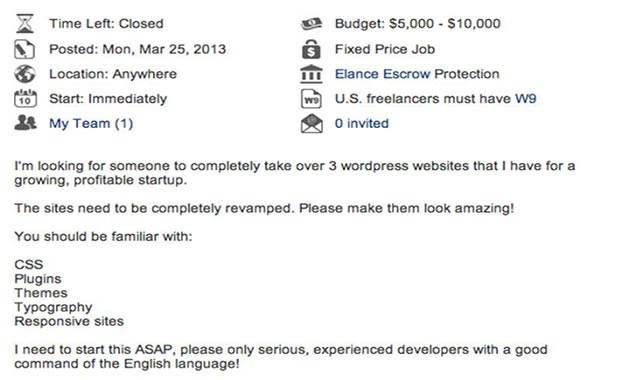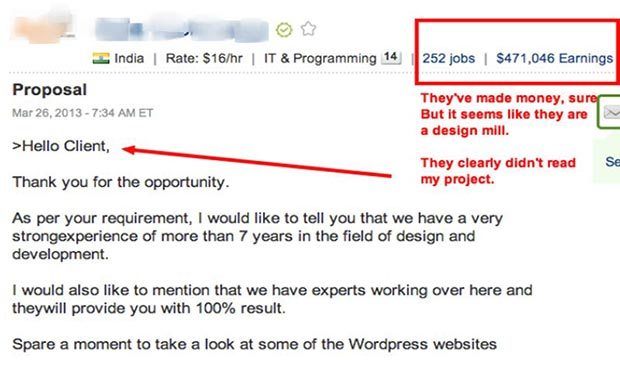Entrepreneurs
How To Make $24,000 In 4 Weeks Freelancing Online

If you had to make an extra $100 this week, could you do it? Most people would probably say yes.
But what about an extra $1,000? Hmm…now that’s quite a bit harder. Most of us might have a difficult time getting that amount of money together at a moment’s notice.
How about an extra $5,000? If you had an emergency, could you pull together a spare $5k for an unplanned expense? For 99.9% of the population, the answer is a resounding “Hell No!”
But it doesn’t have to be that way.
In today’s article, I’m going to show you the step-by-step process I used to make almost $24,000 in a single month — that’s just about $6,000/week.
I didn’t borrow the money from a rich uncle or do weird, illegal things to get it. I simply used skills I already had to pitch myself and start a freelance business.
I’ll break down exactly how I did it below — and if this article helps you, read to the end, where I’ve created a free bonus full of advanced material + strategies.
“Sell yourself first, if you want to sell anything.” – Burt Lancaster
When people ask me what the best ways to make money are, sometimes I laugh. Not because the question is stupid, but because, well, there really is no “right” answer. The truth is that almost anything can make money. But first, you have to change your mindset.
You must start viewing your skills and experiences as bankable, valuable resources worth paying for. You (yes, you) can help someone with skills and knowledge that you already have. The easiest way to do this is by freelancing. (If you’re struggling to think of valuable skills, here are some ideas and specific examples.)
All that being said … I have good news and bad news for you.
The good news: There are several online freelance marketplaces like Elance and oDesk that allow you to offer your services, get clients, and start making money quickly, even if you’re a complete beginner.
The bad news: These freelance marketplaces can be extremely competitive and overwhelming. If you don’t know what you’re doing, the competition can be very intimidating.
But don’t let that discourage you.
Today, I’m going to show you the simple “hack” I used to make $24,000 on Elance in four weeks designing simple WordPress websites. (Note: the strategies here apply for any freelance skill, not just web design.)
If you stick around until the end, I’ll also give you some tools to help you get an even bigger jump on the competition.
Step 1: Use sneaky research on your competition
Before you start, you’ll need to know what exactly you’re getting yourself into.
Specifically, you need to know:
- Exactly what strategies your successful competitors use to stand out in the crowd
- How you can completely obliterate them by being ridiculously over-prepared
To find the answers to these questions for myself, I posted a fake job to see what types of responses I would get. I recommend you do the same!
Here’s what I posted on Elance:

One note here: It’s not really necessary for you to post a fake job like I did in order to get good results. The big idea here is to show you what happens when you actually test your process and then act on those results.
Here’s what I learned with the results from my test …
Step 2: Analyzing the results
Within 30 minutes, I received almost 100 proposals — and I learned two very valuable insights:
- Over half of the applicants to my job were non-native English speakers.
- Most people were submitting “canned” proposals without any personalization.
Once I figured these critical pieces of info out, I knew I had a unique angle. Why?
Well, most people hiring freelancers are from the US/UK — which means that oftentimes, there’s a language barrier. People are always more comfortable communicating in their native language.
And because of this language barrier, most proposals were very dry and uninteresting.
Here’s one that I received …

You can do much better. Here’s how …
Step 3: How to stand out and start booking jobs
To stand out against a sea of freelancers, you have to show that you understand your potential client and provide them with a reason to give your proposal a second look. Your approach should feel warm, engaging, and above all, personalized.
Nobody wants to feel like they’re #573 for the day.
Research your prospective client’s profile beforehand and look for these details:
- Purchase history — Do they regularly hire on Elance? If so, this is a good sign that they are serious.
- Feedback history — What type of feedback do they have for freelancers they’ve hired in the past. What have they liked/disliked?
- Personal details — Name, interests, location, etc. Anything you might be able to relate to and build some rapport.
“Why fit in when you were born to stand out.” – Dr. Seuss
The knockout punch: video “mini-pitches”
Once you’ve rounded up all this information, use it to create a short “mini-pitch” with an unlisted YouTube video.
Your “mini-pitch” should:
- Be 90 seconds or less
- Introduce youself and give a very brief background
- Tell them why you like their specific project (so they know you actually read it)
- Offer a simple “call to action” to get in touch with you
Bonus: if you can include some relevant personal details that you have in common, it helps.
From there, the process is simple. Rather than sending a regular proposal like everyone else, just send them a quick message with a link to your custom video.
This method works SHOCKINGLY well because it differentiates you from the crowd and shows that you truly care about what they’re working on.
You can’t fake that.

Get the step-by-step strategies, videos and scripts I used to make $24,000 in 4 weeks
At this point, you’re probably wondering what this approach actually looks like in REAL life.
I put together an extended guide on “Hacking Elance” that includes:
- The exact scripts and screenshots I used to book jobs and negotiate with clients
- Real “mini-pitch” videos I sent that resulted in thousands of dollars
- The biggest mistakes people make when trying this approach (and how you can avoid them)
- A checklist for dealing with common client objections
Business
The Hidden Money Pit in Your Operations (and How to Use It)
See how smart asset management software is quietly saving businesses thousands in wasted time, stock, and maintenance.

Trimming unnecessary expenses and minimizing resources is a general practice in running a business effectively. Asset management software can help you achieve those goals. (more…)
Business
Thinking of Buying A Business? These 6 Sectors Quietly Produce the Best Deals
Before you buy your next venture, check out the sectors where successful businesses are changing hands every day.

All entrepreneurs have a desire to be the masters behind a successful venture. Buying an established business is a great choice for many. This provides instant access to an established market with existing infrastructure and clients. (more…)
Business
The Entrepreneur’s Reading List That Transforms Ideas Into Empires
These must-read titles and writing insights reveal how entrepreneurs turn bold ideas into empire-level success.

Entrepreneurship is powered by stories—of accomplishment, failure, and decision moments that define businesses. Books are maps, providing insight from individuals who’ve traversed the road ahead. (more…)
Entrepreneurs
The Leadership Shift Every Company Needs in 2025
Struggling to keep your team engaged? Here’s how leaders can turn frustrated employees into loyal advocates.

In workplaces around the world, there’s a growing gap between employers and employees and between superiors and their teams. It’s a common refrain: “People don’t leave companies, they leave bad bosses.”
While there are, of course, cases where management could do better, this isn’t just a “bad boss” problem. The relationship between leaders and employees is complex. Instead of assigning blame, we should explore practical solutions to build stronger, healthier workplaces where everyone thrives.
Why This Gap Exists
Every workplace needs someone to guide, supervise, and provide feedback. That’s essential for productivity and performance. But because there are usually far more employees than managers, dissatisfaction, fair or not, spreads quickly.
What if, instead of focusing on blame, we focused on building trust, empathy, and communication? This is where modern leadership and human-centered management can make a difference.
Tools and Techniques to Bridge the Gap
Here are proven strategies leaders and employees can use to foster stronger relationships and create a workplace where people actually want to stay.
1. Practice Mutual Empathy
Both managers and employees need to recognize they are ultimately on the same team. Leaders have to balance people and performance, and often face intense pressure to hit targets. Employees who understand this reality are more likely to cooperate and problem-solve collaboratively.
2. Maintain Professional Boundaries
Superiors should separate personal issues from professional decision-making. Consistency, fairness, and integrity build trust, and trust is the foundation of a motivated team.
3. Follow the Golden Rule
Treat people how you would like to be treated. This simple principle encourages compassion and respect, two qualities every effective leader must demonstrate.
4. Avoid Micromanagement
Micromanaging stifles creativity and damages morale. Great leaders see themselves as partners, not just bosses, and treat their teams as collaborators working toward a shared goal.
5. Empower Employees to Grow
Empowerment means giving employees responsibility that matches their capacity, and then trusting them to deliver. Encourage them to take calculated risks, learn from mistakes, and problem-solve independently. If something goes wrong, turn it into a learning opportunity, not a reprimand.
6. Communicate in All Directions
Communication shouldn’t just be top-down. Invite feedback, create open channels for suggestions, and genuinely listen to what your people have to say. Healthy upward communication closes gaps before they become conflicts.
7. Overcome Insecurities
Many leaders secretly fear being outshone by younger, more tech-savvy employees. Instead of resisting, embrace the chance to learn from them. Humility earns respect and helps the team innovate faster.
8. Invest in Coaching and Mentorship
True leaders grow other leaders. Provide mentorship, career guidance, and stretch opportunities so employees can develop new skills. Leadership is learned through experience, but guided experience is even more powerful.
9. Eliminate Favoritism
Avoid cliques and office politics. Decisions should be based on facts and fairness, not gossip. Objective, transparent decision-making builds credibility.
10. Recognize Efforts Promptly
Recognition often matters more than rewards. Publicly appreciate employees’ contributions and do so consistently and fairly. A timely “thank you” can be more motivating than a quarterly bonus.
11. Conduct Thoughtful Exit Interviews
When employees leave, treat it as an opportunity to learn. Keep interviews confidential and use the insights to improve management practices and culture.
12. Provide Leadership Development
Train managers to lead, not just supervise. Leadership development programs help shift mindsets from “command and control” to “coach and empower.” This transformation has a direct impact on morale and retention.
13. Adopt Soft Leadership Principles
Today’s workforce, largely millennials and Gen Z, value collaboration over hierarchy. Soft leadership focuses on partnership, mutual respect, and shared purpose, rather than rigid top-down control.
The Bigger Picture: HR’s Role
Mercer’s global research highlights five key priorities for organizations:
-
Build diverse talent pipelines
-
Embrace flexible work models
-
Design compelling career paths
-
Simplify HR processes
-
Redefine the value HR brings
The challenge? Employers and employees often view these priorities differently. Bridging that perception gap is just as important as bridging the relational gap between leaders and staff.
Treat Employees Like Associates, Not Just Staff
When you treat employees like partners, they bring their best selves to work. HR leaders must develop strategies to keep talent engaged, empowered, and prepared for the future.
Organizational success starts with people, always. Build the relationship with your team first, and the results will follow.
-

 Change Your Mindset4 weeks ago
Change Your Mindset4 weeks agoWork-Life Balance Isn’t a Myth: Here’s How to Actually Make It Happen
-

 Life3 weeks ago
Life3 weeks ago9 Harsh Truths Every Young Man Must Face to Succeed in the Modern World
-

 Success Advice3 weeks ago
Success Advice3 weeks agoInside the TikTok Resume Hack That’s Fooling Recruiters (For Now)
-

 Change Your Mindset2 weeks ago
Change Your Mindset2 weeks agoThe One Leadership Habit That Separates the Great From the Forgettable
-

 Personal Development2 weeks ago
Personal Development2 weeks agoThis Silent Habit Might Be Sabotaging Your Career
-

 Business1 week ago
Business1 week agoWhy Your E-Commerce Fulfilment Is Probably Broken (And How to Fix It)
-

 Shift Your Mindset6 days ago
Shift Your Mindset6 days ago11 E’s That Define Every Great Leader And Why Most People Miss Them
-

 Business4 days ago
Business4 days agoThe Hidden Money Pit in Your Operations (and How to Use It)


























6 Comments